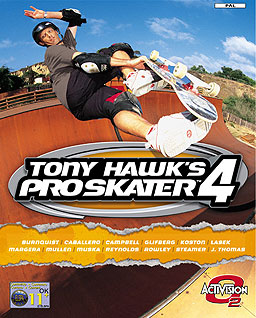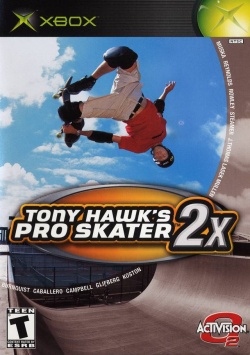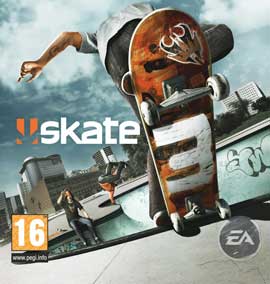
Robert Dean Silva Burnquist is a Brazilian-American professional skateboarder who competed for Brazil throughout his career. In 2010, he became the first skateboarder to land a "fakie 900", making Burnquist the fifth person in history to successfully complete the 900 trick.

Anthony Frank Hawk, nicknamed Birdman, is an American former professional skateboarder, entrepreneur, and the owner of the skateboard company Birdhouse. A pioneer of modern vertical skateboarding, Hawk completed the first documented "900" skateboarding trick in 1999. He also licensed a skateboarding video game series named after him, published by Activision that same year. Hawk retired from competing professionally in 2003 and is widely regarded as one of the greatest and most influential skateboarders of all time.

Tony Hawk's Pro Skater, released as Tony Hawk's Skateboarding in the UK, Australia, New Zealand, and parts of Europe, is a 1999 skateboarding video game developed by Neversoft and published by Activision. It is the first installment in the Tony Hawk's series. It was released for the PlayStation on September 29, 1999 and was later ported to the Nintendo 64, Game Boy Color, Dreamcast, and N-Gage.

Tony Hawk's Underground is a 2003 skateboarding video game and the fifth entry in the Tony Hawk's series, following Tony Hawk's Pro Skater 4. It was developed by Neversoft and published by Activision for the GameCube, PlayStation 2, Xbox, and Game Boy Advance. In 2004, it was published for Windows in Australia and New Zealand as a budget release.

Tony Hawk's Pro Skater 2 is a 2000 skateboarding video game developed by Neversoft for PlayStation, Vicarious Visions for Game Boy Advance, and Natsume for Game Boy Color. Published by Activision, it is the second installment in the Tony Hawk's series of sports games, and was released for the PlayStation in 2000, with subsequent ports to Windows and Dreamcast alongside a distinct version for Game Boy Color the same year. In 2001, the game was ported to Mac OS, Mac OS X, Nintendo 64, and Xbox, alongside a separate version for Game Boy Advance. The game was later ported to Windows Mobile and Windows Phone devices in 2006 and to iPhone OS devices in 2010.

Tony Hawk's Pro Skater 4 is a 2002 skateboarding game developed by Neversoft and published by Activision under their Activision O2 label. The game was ported by different developers to various systems. It is the fourth installment in the Tony Hawk's series. The game was released in 2002 for the GameCube, PlayStation, PlayStation 2, Xbox, and Game Boy Advance. In 2003, it was released for Windows and Mac OS X by developer Beenox and publisher Aspyr. In 2004, a Tapwave Zodiac version was released.

Aggressive Inline is a 2002 sports video game developed by Z-Axis and published by AKA Acclaim. The game simulates aggressive inline skating, with players completing tricks and objectives in open-ended levels. The game was released in North America for the PlayStation 2 on May 29, 2002, followed by GameCube and Xbox versions in August. A Game Boy Advance version was released by Full Fat in August 2002. The developers of Aggressive Inline aimed to innovate upon the formula of the Tony Hawk's series of extreme sports games, building on the engine and tools of the developer's previous title, Dave Mirra Freestyle BMX 2. The developers experimented with gameplay features, including the inclusion of open-ended level design and greater environmental interaction, an organic skill progression system, and the removal of fixed time limits, many of which had not been implemented in an extreme sports game before.

Dave Mirra Freestyle BMX is a 2000 BMX video game developed by Z-Axis and published by Acclaim Entertainment under their Acclaim Max Sports label. The game was released on the PlayStation, Game Boy Color, Dreamcast and Microsoft Windows. The player's main objective in the game is to choose one of the riders and work their way through a total of 12 different levels, completing objectives to unlock new equipment. It received "favorable" reviews. A sequel, Dave Mirra Freestyle BMX 2, released in 2001.

Dave Mirra Freestyle BMX 2 is a 2001 BMX video game developed by Z-Axis and published by Acclaim Entertainment under their Acclaim Max Sports label. It is the sequel to Dave Mirra Freestyle BMX. It was released for the PlayStation 2 in August 2001, and in the following months it was ported to the GameCube, Game Boy Advance, and Xbox video game systems. Both the GameCube and Xbox ports featured two extra levels that were not present in the PS2 version.

AirBlade is a sports video game developed by Criterion Games and published by SCEE in Europe and Namco in North America. It is the spiritual successor to the Dreamcast game TrickStyle. It was released on 9 November 2001 in Europe and 28 January 2002 in North America for the PlayStation 2.

Mat Hoffman's Pro BMX is a 2001 BMX video game developed by Shaba Games and the first game to be published by Activision under the Activision O2 label. It is similar to the Tony Hawk's series and competed directly with Acclaim Entertainment's Dave Mirra Freestyle BMX. Despite a planned release in fall of 2000, the game was released in 2001 for the PlayStation and Game Boy Color, followed by Dreamcast, Microsoft Windows and Game Boy Advance. The PlayStation and Dreamcast versions received "favorable" reviews, while the PC and Game Boy Advance versions received "average" reviews. A sequel, Mat Hoffman's Pro BMX 2, was released in 2002.

Evolution Skateboarding is a sports video game released by Konami for the GameCube and PlayStation 2 in 2002. It includes several popular skateboarders such as Rick McCrank, Arto Saari, Kerry Getz, and Danny Way. There is also a create-a-skater feature and an unlockable character for every skater the player completes the game as. There are also sets of level specific songs such as a metal-remix of the Metal Gear Solid theme and a Castlevania theme after unlocking the Vampire Hunter. Levels are unlocked by beating a certain amount of objectives in a current level, such as collecting items like boots and other objects, performing tricks in certain areas of a level, and grinding a certain amount of meters. The Evolution Skateboarding engine was used in the bonus skateboarding mode included in the PlayStation 2 version of Metal Gear Solid 2: Substance in 2003.

Tony Hawk's Pro Skater 2x is a 2001 skateboarding video game in the Tony Hawk's series. Developed in a collaboration between Neversoft and Treyarch, and published by Activision under the Activision O2 label, Pro Skater 2x is a re-release featuring the 19 levels from Tony Hawk's Pro Skater and Pro Skater 2, as well as five original levels. Some elements from the then-recently released Pro Skater 3 were included, along with other new features. It was released in North America for Xbox on November 15, 2001 as a launch title for the system.

Whirl Tour is a sports video game developed by Papaya Studio and co-published by Crave Entertainment and Vivendi Universal Games for GameCube and PlayStation 2.
William Corey Duffel known as Corey Duffel, is a professional skateboarder from Walnut Creek, California.

Tony Hawk's Pro Skater 5 is a 2015 skateboarding video game developed in a collaboration between Robomodo and Disruptive Games, and published by Activision. The tenth main installment in the Tony Hawk's series, the game is the first new title in the main series since 2007's Proving Ground and the first Pro Skater since 2002's Pro Skater 4, as the series had been put on hold following a lack of critical and commercial success with later games.

Skate 2 is a skateboarding video game developed by EA Black Box and published by Electronic Arts. The game was released worldwide in January 2009 for PlayStation 3 and Xbox 360 after the spin-off title Skate It. It is the sequel to 2007's Skate and the third installment in the Skate series overall.

3Xtreme is a racing game released for the PlayStation in 1999. As with 2Xtreme, 3Xtreme contains skateboarding, skating, and cycling options to reach the goal before opponent players.

Skate 3 is a skateboarding video game, the third installment in the Skate series and the sequel to 2009's Skate 2, developed by EA Black Box and published by Electronic Arts. It was released worldwide in May 2010 for PlayStation 3 and Xbox 360. The game takes place in the fictional city of Port Carverton, which embraces skateboarding, unlike considering it a crime in the second game. The player character goes by the alias "The Legend". After failing to "Jump The Shark", their goal becomes creating a successful skateboarding team. It is the player's goal to sell one million boards by completing challenges. The game introduced some new features including new tricks, a park builder, and "Easy" and "Hardcore" modes instead of just "Normal" mode.

Tony Hawk's Pro Skater 1 + 2 is a 2020 skateboarding video game developed by Vicarious Visions and published by Activision. It was released for PlayStation 4, Windows, and Xbox One on September 4, 2020, PlayStation 5 and Xbox Series X/S on March 26, 2021, and Nintendo Switch on June 25 of the same year. It is a remake of the first two games in the Tony Hawk's series: Tony Hawk's Pro Skater (1999) and Tony Hawk's Pro Skater 2 (2000), which were originally developed by Neversoft. It is the first major console game in the series since Tony Hawk's Pro Skater 5 (2015) and is Vicarious Visions' final work as a subsidiary of Activision before it was merged into Blizzard Entertainment on January 22, 2021.



















